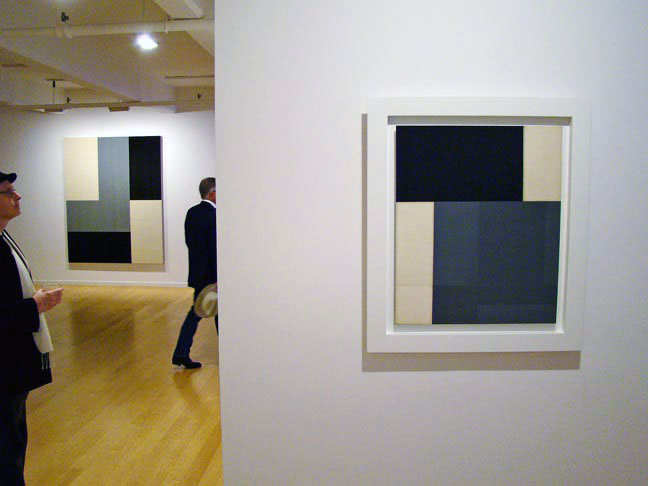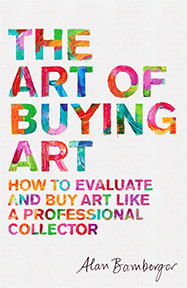Turn Art Lookers
Into Art Buyers
I go to a lot of art openings and typically don't hang around all that long at any one gallery. I look at the art and when possible have a few words with the artist or read the statement or press release, after which it's on to the next show. I recall a chance encounter with an artist whose opening I had seen several nights before. We spoke briefly, and I mentioned how much I enjoyed the show. The artist thanked me and as we were about to part, asked somewhat cryptically, "Did you look at the art?" with emphasis on the word "look." Without thinking, I answered, "Of course," but then got to wondering, well... did I really look at it? Yes I did, but the artist's implication seemed to be that perhaps not enough, as if there could be a required minimum looking time. Hmmm.
So I got to thinking, what does it mean to "look at the art," and even more to the point, what does it mean to look at it enough? Enough according to whom? Does "enough" mean to become so fascinated or involved that you want to know more? That you want to follow the artist on social media? That you want to buy? What's the endgame here? I guess the only way to answer these questions is to consider the "act of looking" from both the artist's and viewer's perspectives.
Let's start with the artist. If you're an artist, whose responsibility do you think it is to make sure people look at your art "enough," and even more importantly, that their experience of looking is a productive one? Would it be theirs or yours? Right. Yours. And whose responsibility do you think it is to make sure they continue to look at your art for as long as possible? Right again. Yours.
We live in a world where people are free to look at whatever they feel like looking at for as short or as long as they want, and decide what to do next based on what they see-- or think they see. Options include looking longer, learning more, striking up a conversation, following you on social media, moving on, etc. Whether they're looking at your art in person or online, if you're among those artists who would like viewers to look longer and learn more, it's on you to figure out exactly how to accomplish that.
I'm amazed at how many artists think viewers are the ones responsible not only for looking at their art long enough to appreciate it, but more importantly, for learning about it entirely on their own. It's almost like they believe that anyone who really wants to own their art somehow has to prove it. Do artists actually think that viewers are supposed to do all the work-- even work to buy it-- while they sit back and wait for the sales to roll in? Apparently some do.
Now consider the viewer. As you might expect, people who like to look at art see things differently. They approach art more casually, visit galleries when they get the chance or browse art online, and do so mainly for enjoyment. Maybe they discover new artists by scrolling through Instagram, or walking into a gallery by chance, or going to open studios, or accidentally stumble on an artist's website and like what they see. One thing they rarely do is set out for the sole purpose of buying art. Generally speaking, art has to absolutely nail someone for them to stop in their tracks, shut up, stand still, stop scrolling, and give it more than a passing glance-- either in person or online. Take you, for instance. You see plenty of art. How often do you stop and stare for any significant length of time? Precisely. Not that often. So on those occasions when people do slow down or stop to look at your art, you have to be ready.
The truth is that most encounters with art are brief, and most people, unless they're presented with really good reasons to continue looking, not the least of which is the art's immediate visual impact, they tend to move on. What kind of reasons? Aside from fascination with the art itself, reasons they can understand and identify with, ones that welcome and introduce them to the art, and reel them in for more-- reasons YOU the artist provide. Otherwise, they're likely off to the next work of art or artist or gallery or Instagram feed or website or whatever. Yes, once they slow down, it's your job to keep them slowed down, hopefully to the point where they become so enthralled with how you engage them about your work, they'll ultimately want to take a piece of your creative self home and make it a part of their lives.
How do you accomplish this? For starters, wherever you post or show your art, provide brief written descriptions that anyone can understand, appreciate and connect with on some fundamental level-- really fast, no matter who they are or how much or how little they know about art-- from average folks to MFAs. And make it instantly and easily accessible with either a scroll, mouse-click, at the entrance to your studio, sitting on a gallery's front desk, or on the homepage of your website. Keep it brief, and please oh please, avoid art jargon that requires an art education to interpret.
On social media, limit descriptions or explanations to one to two sentences whenever possible. In other situations, one to three paragraphs of two to three sentences each is all you need. Don't worry about having to impress people who know a lot about art; if they have more complicated questions, they'll ask. It's always best to stick with the basics and keep everyone in the game. Most people who like art don't really know that much about it, and the very large majority of them will be more than satisfied with the basics.
Think of this introduction like a movie trailer, like sampling a song on iTunes, like the introduction to a book. Convincing someone to pay to see a movie or buy books or music is remarkably similar to convincing someone to buy your art. No matter what they're buying, potential buyers almost always start with these types of "promos" or intros. The more compelling the introduction, the more compelled they are to continue. First the art slows them down. When there's a quick concise explanation at hand, chances are excellent they'll read it. If they feel like they have a grip on what they're looking at-- assuming it resonates with them in other ways as well-- they're far more likely to follow through and continue the conversation than those who don't.
If your art simply sits there unexplained, either online or in real life, those who slow down for a closer look won't stay slowed down for long. Why? Because once they're done looking, there's nothing left for them to do but leave. And don't expect them to act on their own, ask for help, or plead to know more. Why? Because many people feel intimidated, uncomfortable, awkward, or afraid to open their mouths for fear of saying something dumb or stupid. Or if they're looking online, they're reluctant to make contact because they're afraid of being pressured, saying the wrong thing, being added to email lists, finding out the art costs way more than they can afford, and so on. So please-- give them a fighting chance to understand, appreciate, decide to make contact, and hopefully end up buying your art.
Forget this mindset that people who want to buy art have to get up to speed on their own. That is a lose-lose proposition, and so outdated and elitist as to be laughable. Maybe that worked in the good old days where newbies had to want it bad enough, and if it was hard to understand, that meant it had to be good. But not any more. The business has changed big time. Art buyers no longer believe that artists and/or art dealers possess special wisdom that can be attained only if they tremble in deference, ask no questions, and always agree in order to earn the right to buy. Now that we have the Internet, information is everywhere, and anyone who's interested in art has scrillions of options and opportunities to see, learn about, fall in love with, and buy art like never before.
Do your best to give anyone interested in your art whatever information they want. They want to know basics like what they're looking at, what they're getting for their money, why its significant, how you priced it, what it means, how you made it, what your resume looks like, what the prognosis may be for the future, and more. Potential buyers want to feel like they're making intelligent choices, that they understand the art, that it adds to their lives, and that they're getting good value (tangible as well as intangible) for what many consider to be "investments." And last but not least, when their friends come over for dinner and say stuff like, "Bob, is that art new?", Bob will be prepared to share his knowledge and impress them with his discriminating good taste and sophistication-- and emerge a winner-- which he could never have done without your help.
Several more hints for crafting compelling copy:
* Your introductory should answer typical questions viewers ask when they first see your art. If you're like most artists, you already know what people like about it and what types of questions they ask. So make it easy for first timers, feed them those answers up front, and save them the time and trouble of struggling to figure out why they like what they're looking at.
* Have a one or two sentence description or explanation of each work of your art, and be specific-- specifics are easier to grasp than generalities. Your description can be about anything-- color, shape, size, materials, medium, inspiration, mood, thoughts, justifications, beliefs, the music you listened to while you made it, why you made it, where you made it, how you made it, how long it took to make, and so on. Keep it simple; keep it clear, and make viewers want to know more.
Remember-- nobody owes you or your art one nanosecond of attention. It is your responsibility and yours alone to convince people that what you communicate through your art and what your art stands for is significant, meaningful, worth paying attention to, and worthwhile enough for them to make it a part of their lives. It's that simple and no more complicated.

(art by Robert Kelly)

Current Features
- How to Buy Art on Instagram and Facebook
More and more people are buying more and more art online all the time, not only from artist websites or online stores, but perhaps even more so, on social media ... - Collect Art Like a Pro
In order to collect art intelligently, you have to master two basic skills. The first is being able to... - San Francisco Art Galleries >>


